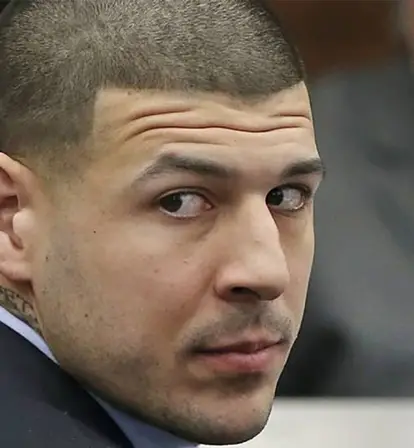Raised in an abusive household in Bristol, Connecticut, Aaron Hernandez became a star in the NFL — and may have murdered multiple people in the early 2010s.
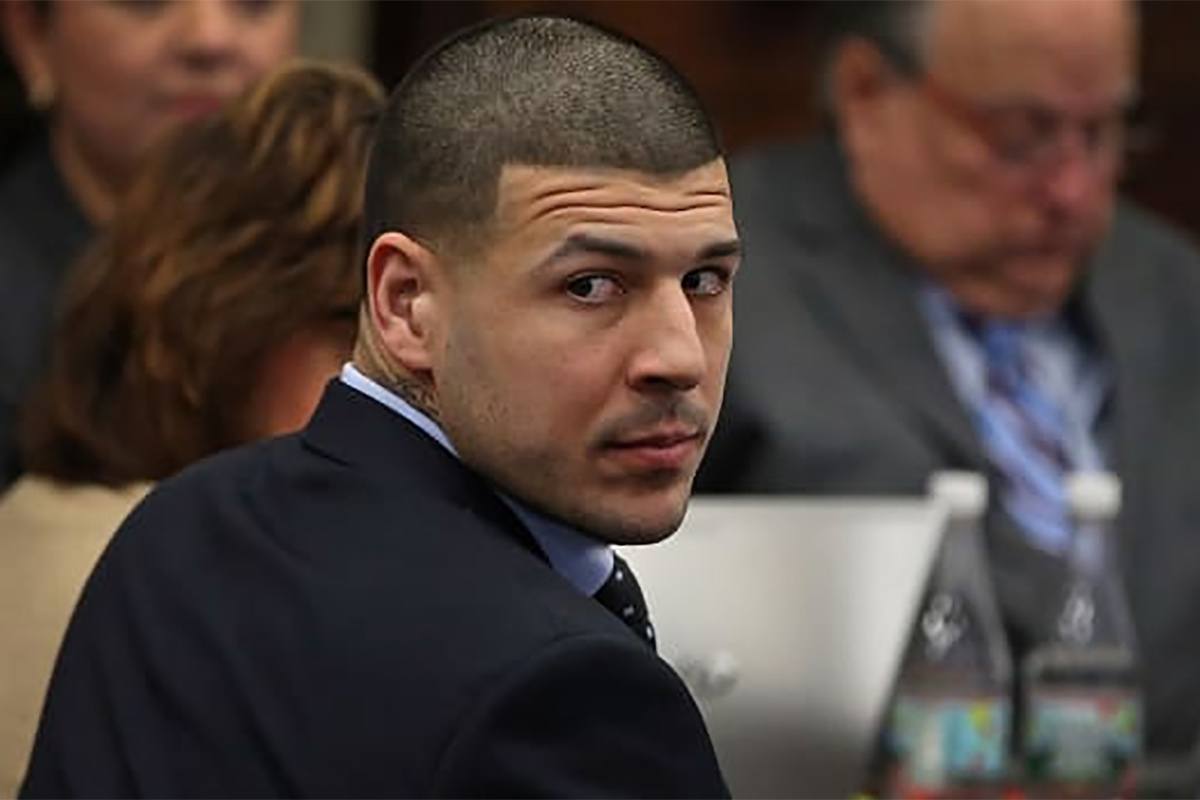
Getty ImagesFrom an abusive childhood to NFL stardom to his role in at least one murder, Aaron Hernandez lived a turbulent life shaped by tragedy before dying at 27.
In 2012, star NFL tight end Aaron Hernandez got engaged, welcomed his first child, caught a touchdown in the Super Bowl, and signed one of the most impressive contracts in league history. The following year, the 23-year-old superstar was arrested for murder and saw his career and his life fall apart instantly.
Not only did it quickly become clear that Aaron Hernandez had murdered his friend Odin Lloyd, but he had also been hiding years of criminal misdeeds that could have landed him behind bars before his career even got started.
While his on-field stock was rising throughout high school, college, and his first NFL seasons, Aaron Hernandez was implicated in drug use, felony battery, and even a double murder that occurred nearly a full year before the one that finally put him in jail.
And though he may have been able to get away with a long list of misdeeds, when Aaron Hernandez murdered Lloyd, he finally faced justice in a way he never had before. Then, two years after beginning his life sentence for that crime, he killed himself in his prison cell on April 19, 2017, at the age of just 27.
But even after Hernandez’s death, the reasons behind his violent acts remained something of a mystery. From childhood abuse to alleged struggles with homosexuality to brain damage suffered on the field, the motives for Aaron Hernandez’s many crimes complicate his chilling story in ways that few would have ever suspected.
The Tragic Early Story Of Aaron Hernandez That Most People Don’t Know

John Tlumacki/The Boston Globe/Getty ImagesThe childhood home of Aaron Hernandez at 189 Greystone Ave. in Bristol, Connecticut. He and his brother were violently abused here on a regular basis by their alcoholic father.
Aaron Josef Hernandez was born on November 6, 1989, in Bristol, Connecticut. According to The Boston Globe, his father Dennis — a former janitor who was nicknamed “The King” — wanted nothing more than for his sons to reach athletic stardom.
But Dennis was also a violent alcoholic who so regularly and brutally abused his sons that Hernandez was said to show up to high school practice with clear signs of beatings on a regular basis.
“I picked up the phone once to call, to seek help,” his brother Jonathan said about alerting the authorities to their father’s violent beatings. “And his response was, ‘Call them.’ And he handed me the phone, and he said, ‘I’m going to beat you even harder, you and your brother, and they’re going to have to pull me off of you when they knock down the door.'”
Furthermore, Hernandez and Jonathan both claimed that the former was even sexually molested as a child, though not by his father. Aaron Hernandez was reportedly forced to perform oral sex on an older boy for years, starting when he was just six.
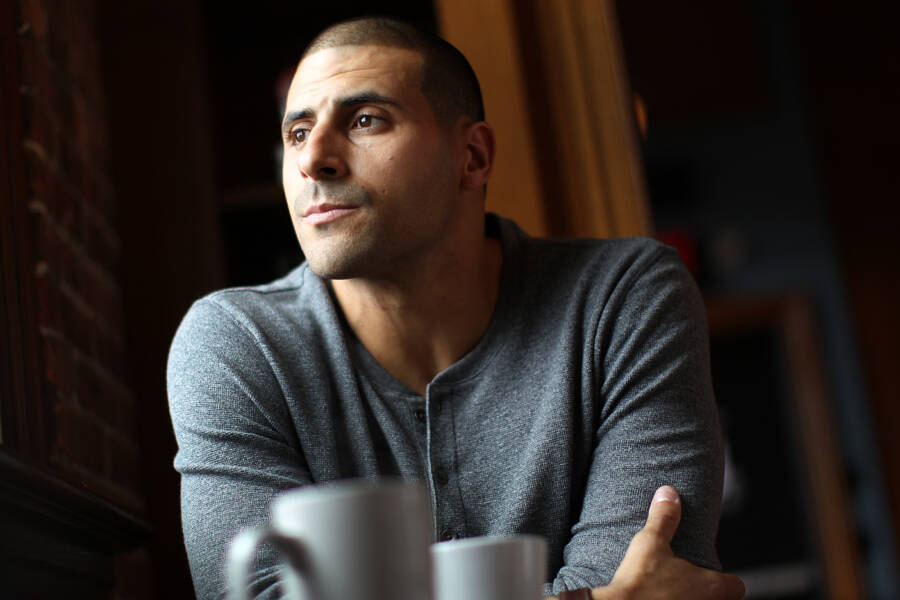
Suzanne Kreiter/The Boston Globe/Getty ImagesJonathan Hernandez (above, pictured in 2018) claimed his late brother was sexually abused when he was six years old. Both brothers were also frequently beaten by their father.
Following this near-constant stream of both physical and sexual abuse, Hernandez’s world was rocked once again when Dennis died from complications after a routine hernia surgery at the age of 49 in 2006.
Those closest to him said that the 16-year-old Hernandez never got over his father’s death — despite the abuse he’d suffered at his hands. Nevertheless, Dennis got his wish and did leave behind a son who excelled at football — but one who was also emotionally and psychologically damaged due to the years of abuse of him, his brother, and his mother.
And it was after his father’s death that Aaron Hernandez started to turn toward a life of violence and crime.
“Just Reckless”: Aaron Hernandez’s Life And Crimes Outside Of The Football Spotlight
Despite his traumatic childhood and largely because of his football success, Aaron Hernandez was a popular student at Bristol Central High School, where he began dating future fiancée Shayanna Jenkins. But he also began smoking marijuana heavily — both before and after football practice. And though the rising football star was soon recruited by the University of Florida, his drug use and budding criminal exploits kept putting black marks on his record.
Though Hernandez received a football scholarship from the University of Connecticut — the school his father had attended and the one his brother also chose to attend — Hernandez was won over by the University of Florida and its legendary coach, Urban Meyer.

University of FloridaAaron Hernandez’s portrait for the University of Florida football team.
Though he had a promising path laid out before him, Hernandez started behaving ever more recklessly after discovering that his mother, Terri, began dating his cousin’s husband. This only exacerbated the trauma of his father’s death. And then, in 2006, Hernandez’s troubles got worse when he suffered the first serious injury of his football career.
“I saw him get hit, and I saw him go down. And he didn’t get back up,” said Lorrie Belmonte, a nurse who watched it unfold from the stands. “He must’ve been totally out of it because they called… the ambulance [that] was standing by. And so the EMTs immediately came up on the field and got him and took him.”
At the time, the neurological link between collisions on the football field and chronic traumatic encephalopathy (CTE) hadn’t yet gained the widespread acceptance that it has today. And while Hernandez seemed to recover from his injury and went back to playing the game he loved, it now appears likely that hits like this began to change him at a fundamental level.
Aaron Hernandez arrived at the University of Florida in January 2007 and quickly became the best tight end on the team. He also ramped up his drug use, neglected his academic coursework, and grew even more unhinged.
“I was so immature, just reckless,” Hernandez later said in a taped phone call from jail.
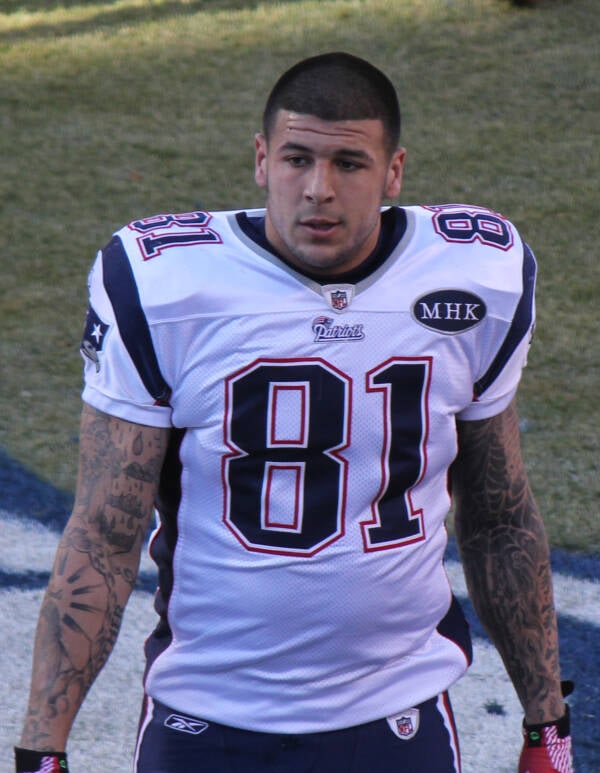
Wikimedia CommonsAaron Hernandez on the field, a year and a half before murdering Odin Lloyd. December 18, 2011.
For one, in April 2007, police were called to a local college bar in Gainesville called The Swamp after Hernandez got into a fight with the manager over a $12 bar tab and “sucker punched in the left ear,” leaving him with a ruptured eardrum.
However, Hernandez then called in Coach Meyer to sort the matter out. The team had high-powered lawyers ready to handle such incidents and the felony battery charges against the star athlete were quickly dropped.
Though his star was growing on the field, his image off the field was only worsening. Hernandez soon failed a drug test and was subsequently suspended for one game. As he himself put it, “every time I was on the field I was high on weed.”
Not long after, he took his infamous 2009 Glock-brandishing selfie (to go along with the equally infamous gang signs selfie he’d taken two years earlier) that would become one of the defining images of his troubled life.

TMZThe 2009 selfie of Aaron Hernandez posing with a gun. The image only grew in infamy after the star athlete’s criminal exploits worsened following his arrival to the NFL.
Hernandez’s Off-The-Field Issues Get Worse
The trouble reached a new level when Aaron Hernandez actually used his guns. In 2007, for example, Hernandez was questioned by Gainesville police alongside three other Florida players and another individual in a double shooting.
According to ESPN, a shooter struck three young men named Randall Carson, Justin Glass, and Corey Smith as they were waiting at a Gainesville traffic light after leaving a nightclub on Sept. 30, 2007. While Smith was shot in the head and Glass was hit in the arm, both survived.
Carson described the individual as “Hispanic” and later picked Hernandez out of a police lineup. Hernandez refused to talk to police and even slept during an interrogation.
In the end, no definitive motive was uncovered and no charges were filed against Aaron Hernandez after Detective Tom Mullins — who was later assigned to reinvestigate the case — determined that he was not the shooter. Carson also later said he never saw Hernandez, but thought it might be him because “they had words earlier at the club.”
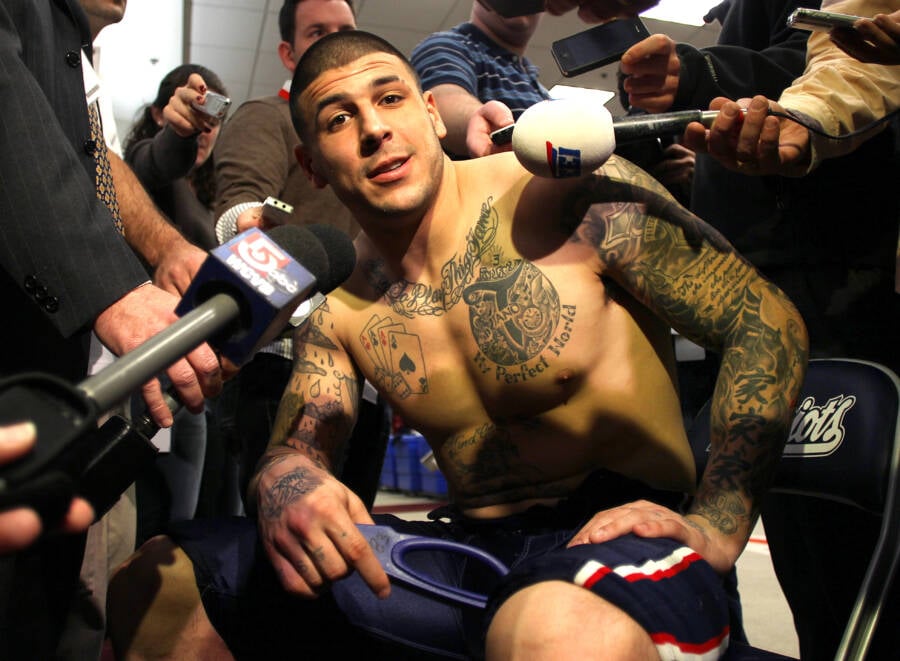
John Tlumacki/The Boston Globe/Getty ImagesNew England Patriots tight end Aaron Hernandez sits with reporters after practice. He would be arrested and charged with murder the following year. January 27, 2012. Foxborough, Massachusetts.
It remains an open question as to whether or not the rising football star had escaped justice once again. But whether he did or didn’t, his reputation as a tight end was only growing.
At the age of 20, the New England Patriots picked up the exceptional yet troubled young star in the 2010 NFL Draft. But his legal troubles were about to get much, much worse.
A Double Murder And A Missing Eye
Things continued to spiral out of control for Aaron Hernandez when he was investigated for a double homicide committed on July 16, 2012, near Boston’s Cure Lounge. Victims Daniel Jorge Correia de Abreu and Safiro Teixeira Furtado were shot and killed in their car and Hernandez later became the prime suspect when witnesses said they saw him pull up beside their car and say “What’s up now, n*ggers?” before firing five shots into the vehicle.
Reportedly, the trouble began earlier that evening inside the nightclub when the victims accidentally spilled a drink on Hernandez. Security camera footage confirms that Hernandez was there that night, though the details of the entire incident still remain murky and contested.
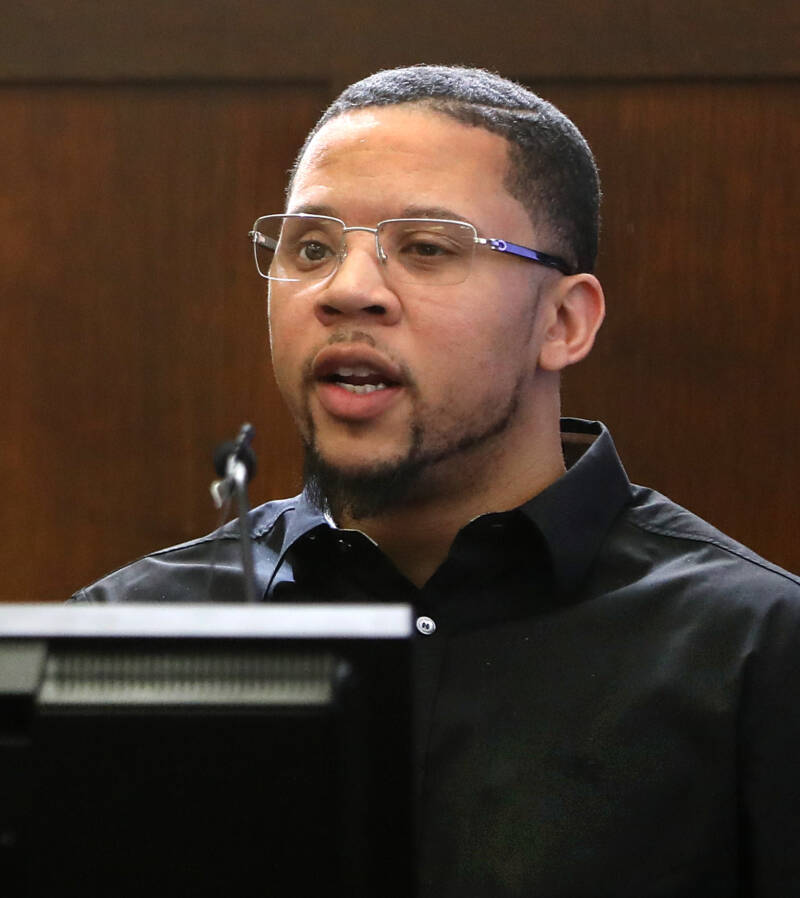
Pat Greenhouse/The Boston Globe via Getty ImagesAlexander Bradley testifies against Aaron Hernandez in Suffolk Superior Court in Boston on March 21, 2017.
In fact, much of the evidence against Hernandez later came from Alexander Bradley, an associate and known drug dealer who provided his subsequent testimony following an incident months after the Cure shooting when Hernandez allegedly shot him in the face for reasons that remain unclear largely because the victim refused to talk to police. Bradley survived the shooting but never forgave Hernandez, later texting him “U left me with one eye and a lot of head trauma.”
With Bradley’s story, Hernandez was indicted on murder charges for the Cure shooting on May 15, 2014. His trial began in March 2017, with Bradley saying Aaron Hernandez killed the pair and Hernandez saying it was Bradley.
Ultimately, Hernandez was found not guilty, some say because the investigation was sloppy and no physical evidence was introduced. According to Jose Baez and George Willis’ Unnecessary Roughness: Inside the Trial and Final Days of Aaron Hernandez, one of the critical mistakes investigators made during the initial crime scene investigation was to carelessly leave the victims’ bodies inside their vehicle even as it was towed away as evidence.

Barry Chin/The Boston Globe via Getty ImagesAaron Hernandez and New England Patriots quarterback Tom Brady talk on the sidelines during a game against the Philadelphia Eagles at Lincoln Financial Field in Philadelphia on Nov. 27, 2011.
This was a major violation of police protocol that disturbed the crime scene and helped make for a lack of physical evidence tying Hernandez to the shooting, all but assuring a not guilty verdict.
But while Aaron Hernandez may have gotten lucky and escaped justice for this shooting, its trial unfolded after he’d already been convicted of another murder, one that ended his football career and sent him to prison for what would remain of his short life.
Aaron Hernandez Murders Odin Lloyd
Odin Lloyd, a semi-professional linebacker for the Boston Bandits football team, was dating Shaneah Jenkins, the sister of Aaron Hernandez’s girlfriend Shayanna Jenkins. Though he and Hernandez developed a relationship thanks to their shared connection, their story ended in bloody fashion when Aaron Hernandez killed him on June 17, 2013.
The 27-year-old Lloyd was last seen alive with Hernandez at about 2.30 a.m. in North Attleborough, Massachusetts. Just after, his body was discovered with two bullet holes in the chest (with other wounds in the arms and side) in a park less than one mile away from Hernandez’s home.
Hernandez immediately became the primary suspect because he was seen with Lloyd in and around Hernandez’s home just beforehand. Investigators showed up at Hernandez’s door within a matter of hours.

Wikimedia CommonsAaron Hernandez was reportedly worried that Odin Lloyd (pictured) would expose him as a homosexual. Hernandez was also angry that Lloyd met with the former’s enemies at a nightclub.
The authorities uncovered a blunt with Hernandez’s DNA near the scene as well as video evidence that showed Hernandez, gun in hand, entering his mansion along with two other men shortly after neighbors reported hearing gunshots in the area.
Aaron Hernandez was arrested on June 26, 2013, and charged with a litany of crimes. He soon pleaded not guilty to six charges that included first-degree murder, unlawful possession of a firearm, and possession of a large-capacity firearm.
Within 90 minutes of his arrest, he was released by the Patriots and his career as an NFL player was over. But even if the case appeared open and shut, the why of it all remained relatively uncertain.
The Trial Of Aaron Hernandez And Why He May Have Killed Odin Lloyd
In court, prosecutors argued that Aaron Hernandez murdered Odin Lloyd after an altercation in a Boston nightclub on June 14. However, the reason for the altercation was not clear, with some saying that it’s because Lloyd was talking to people involved in the 2012 shooting — and others saying it was because Lloyd knew Hernandez was gay and wasn’t going to keep his mouth shut.

Yoon S. Byun/The Boston Globe/Getty ImagesAaron Hernandez in Attleboro District Court one month after being arrested for the murder of Odin Lloyd. July 24, 2013. Attleboro, Massachusetts.
Various pieces of evidence have emerged about Aaron Hernandez’s sexuality, but the picture remains somewhat fuzzy overall. In 2017, investigative reporter Michelle McPhee wrote a story claiming that multiple people close to Hernandez were on the record as saying that Hernandez was gay. The idea gained more traction when reports surfaced that Hernandez had had an affair with a teammate named Dennis SanSoucie in high school and had even come out to his family.
“I could see the betrayal in her face when I mentioned the man [Hernandez had an affair with],” Baez, who once served as Hernandez’s attorney, said of a conversation with Hernandez’s fiancée Shayanna Jenkins, with whom Hernandez had a daughter in 2012. “She knew him and had spent time with him and Aaron. She felt like a fool.”
Even Hernandez’s defense lawyer, George Leontire, claimed Hernandez struggled terribly with his homosexual tendencies.
“Aaron and I talked about his sexuality,” he said. “This man clearly was gay. [He] acknowledged it. Acknowledged the immense pain that it caused him…I think that he also came out of a culture that was so negative about gay people that he exhibited some self-hatred.”
It’s unclear whether or not Lloyd had mocked Aaron Hernandez about this issue or threatened to expose him to his fiancée, but the NFL star’s sexuality and Lloyd’s purported knowledge of it remains a key theory on the motive.
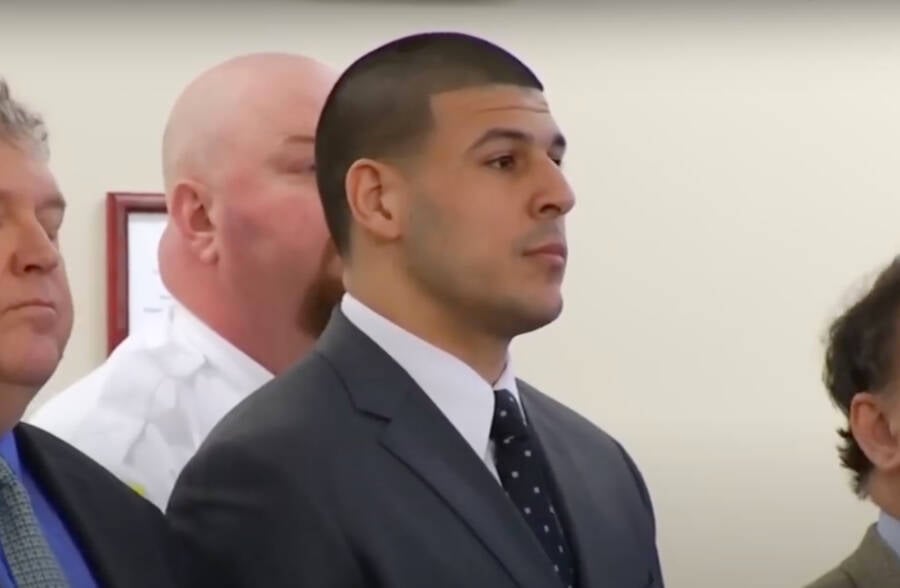
YouTubeAaron Hernandez is sentenced to life in prison for the murder of Odin Lloyd.
Motive aside, Aaron Hernandez was found guilty of Lloyd’s murder on April 15, 2015 and was sentenced to life in prison without the possibility of parole. Hernandez was never going to get out — but within two years, he’d be dead.
“Strangely Content”: The Death Of Aaron Hernandez
In the words of The Boston Globe, Aaron Hernandez was “strangely content” while in prison.
“I have a TV in my cell! And yes I still root for my squad and still love all the ones I love,” he wrote in a letter in 2016.
Some speculate he was content because he no longer had to hide his sexuality behind bars or put up with the enormous pressure of being an NFL star. He even admitted to Jenkins that he’d never felt more at ease.
“I wish I had known how he felt, just so we could have talked about it,” Jenkins later said, alluding to his sexuality. “I wouldn’t have disowned him. I would have been supportive. I can’t fault him if he was feeling that way…The fact that he couldn’t come out to me or he couldn’t tell me these things hurts.”
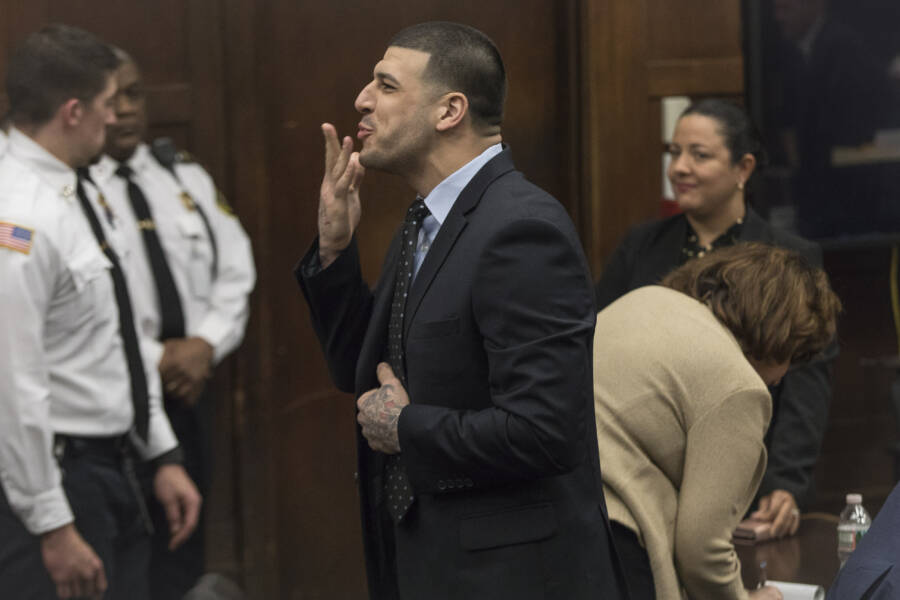
Keith Bedford/The Boston Globe/Getty ImagesAaron Hernandez blowing a kiss to his fiancée, Shayanna Jenkins, while in court for the 2012 double murder. He was later acquitted of the charges. Hernandez committed suicide one week later. April 12, 2017. Boston, Massachusetts.
But even if Hernandez seemed content at times, he ultimately proved that he couldn’t cope.
“Prison is a boring place,” said Wall Street Prison Consultant founder Larry Levine, who served 10 years and now helps people preparing to serve their sentences. “It’s like fucking Groundhog Day. Everybody in there is looking forward to their out date. Hernandez knew he was never getting out.”
Then, on April 17, 2017, McPhee went on a popular Boston-area radio show and publicized the rumors about the star’s sexuality and the possible connections to why Aaron Hernandez murdered Odin Lloyd. Though it remains unclear, some say this would inspire the fallen star’s final act soon after.
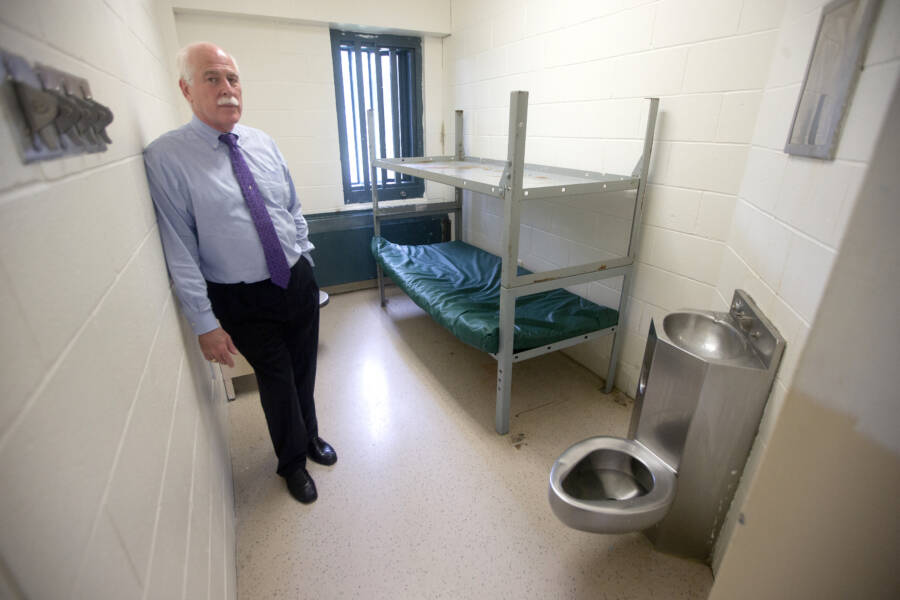
Stan Grossfeld/The Boston Globe/Getty ImagesBristol County Sheriff Tom Hodgson stands inside a 7×10-foot cell in the Bristol County House of Corrections. Aaron Hernandez committed suicide in a cell just like this. December 20, 2010. Foxborough, Massachusetts.
Aaron Hernandez died by suicide on April 19 at the age of 27. He was found hanged in his cell with a suicide letter to his fiancée, in which he pleaded for her to “tell my story fully but never think anything besides how much I love you.”
“This was the Supremes, the Almightys [sic] plan, not mine!”
The book on Hernandez was now closed, even if the Lloyd case was not. Aaron Hernandez’s murder conviction was abated after his death because he died by suicide before his appeal could be heard. But in 2019, a ruling from Massachusetts’ highest court overturned this practice, which reinstated Hernandez’s conviction.
“We are pleased justice is served in this case, the antiquated practice of vacating a valid conviction is being eliminated and the victim’s family can get the closure they deserve,” Bristol County District Attorney Thomas M. Quinn III said.
The now-deceased Aaron Hernandez would forever be known, more than anything else, as a murderer in the eyes of the law as well as the public.
CTE And The Deeper Tragedy Behind Hernandez’s Short Life
Even with Aaron Hernandez gone, revelations about his troubled and violent life continued to come out. Questions about why Aaron Hernandez murdered Odin Lloyd, his guilt in the 2012 shooting, and his sexuality kept swirling.
In January 2020, Netflix released a three-part documentary series called Killer Inside: The Mind of Aaron Hernandez that chronicles Hernandez’s life and career as well as his crimes and his death, and probes into both his sexuality and the post-mortem diagnosis of chronic CTE that some argue addled the young man’s brain and led to his violent behavior.

Getty ImagesThe reasons behind Aaron Hernandez’s suicide remain uncertain, but many suspect CTE was a major factor.
There is sufficient reason to believe that CTE played a major role in why Aaron Hernandez murdered Odin Lloyd and why he may have committed other acts of seemingly inexplicable violence.
Dr. Ann McKee, a neuropathologist who specializes in CTE at Boston University, studied Hernandez’s brain after his death. She found it so plagued by CTE that she was shocked the brain she was studying was any younger than 46 years old.
What is ultimately to blame for Aaron Hernandez’s short, violent, and murderous life is an open question, but the toxic stew of brain damage, childhood trauma, and shame about his homosexuality likely all played a role in shaping his tragic fate.
After learning about the Aaron Hernandez murders and the tragic story behind them, read the chilling tale of another sports-related killing with a look at the John du Pont and Dave Schultz case. Then, learn more about the impact of CTE on NFL players.
